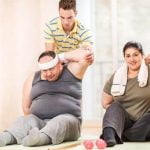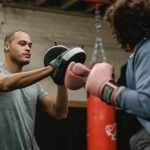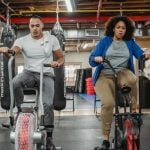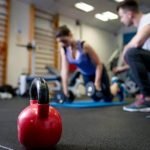For fitness models, sculpted shoulders are often a key component of their overall physique. Strong and defined shoulders not only enhance the aesthetic appeal but also play a crucial role in improving performance and preventing injuries during workouts. In this article, we will delve into the importance of shoulder exercises for fitness models, exploring the anatomy of the shoulder muscles, the benefits of strong shoulders, and the top exercises to achieve those coveted results.
The shoulders consist of a complex network of muscles that allow for a wide range of movement in the upper body. From deltoids to rotator cuffs, each muscle group plays a specific role in stabilizing and mobilizing the shoulder joint.
Understanding the anatomy of these muscles is essential for targeting them effectively with specific exercises tailored to strengthen and shape them. Whether it’s for runway modeling or fitness competitions, having well-developed shoulders can make all the difference in showcasing a toned physique.
Incorporating shoulder exercises into a fitness model’s workout routine is not just about aesthetics but also functional strength and performance. Strong shoulders improve posture, balance, and overall upper body strength, which are essential for various activities like weightlifting, yoga poses, or simply carrying out daily tasks with ease. By focusing on proper form and technique in each exercise, fitness models can maximize their gains while minimizing the risk of injury – a key consideration in any rigorous training regimen.
The Anatomy of the Shoulder
The shoulder is a complex joint that allows for a wide range of motion and is crucial for many daily activities. Understanding the anatomy of the shoulder can help fitness models target specific muscles effectively during their workout routines. The shoulders are made up of three main muscles: the deltoids, rotator cuffs, and trapezius.
- Deltoids: The deltoid muscles are responsible for the overall shape and appearance of the shoulders. They consist of three parts – anterior, lateral, and posterior delts. The anterior deltoid is involved in movements like front raises and overhead presses, while the lateral deltoid is activated during lateral raises. The posterior deltoid comes into play during exercises like reverse flies and rear deltoid raises.
- Rotator Cuffs: The rotator cuffs are a group of four small muscles – supraspinatus, infraspinatus, teres minor, and subscapularis – that help stabilize the shoulder joint. These muscles are essential for maintaining proper shoulder function and preventing injuries. Exercises like internal and external rotations can help strengthen the rotator cuffs.
- Trapezius: The trapezius muscle covers a large portion of the back and upper shoulders. It consists of three parts – upper, middle, and lower traps – each playing a role in different shoulder movements. Fitness models can target the trapezius through exercises like shrugs, upright rows, and face pulls to improve overall shoulder stability and strength.
Understanding how these muscles work together can help fitness models create well-rounded shoulder workout routines that target all aspects of this important joint. By incorporating exercises that target each muscle group within the shoulders, fitness models can achieve balanced muscle development and promote overall shoulder health.
Benefits of Strong Shoulders for Fitness Models
Strong shoulders are not only aesthetically pleasing on fitness models, but they also play a crucial role in overall strength and function. Having well-developed shoulder muscles can improve posture, prevent injuries, and enhance athletic performance. In the world of fitness modeling, where physical appearance is paramount, strong shoulders can help create that desired V-taper look which enhances the overall physique.
One of the key benefits of strong shoulders for fitness models is their ability to support other upper body movements. Whether it’s during a photoshoot or on stage during a competition, having strong shoulders can make a significant difference in how well other muscles are showcased. Additionally, well-developed shoulder muscles can increase stability and support during various exercises like overhead presses, push-ups, and pull-ups, helping fitness models achieve better results in their training.
Furthermore, strong shoulders contribute to an overall balanced physique. By sculpting the deltoid muscles through targeted shoulder exercises, fitness models can achieve symmetry and proportion throughout their upper body. This not only improves physical appearance but also boosts confidence on camera or on stage. Ultimately, having strong shoulders is essential for fitness models to maintain peak performance and aesthetic appeal throughout their careers.
Top 5 Shoulder Exercises for Fitness Models
Shoulder exercises are crucial for fitness models seeking sculpted shoulders that not only look great on stage or photoshoots but also contribute to overall strength and functionality. These exercises target key muscles in the shoulder complex, helping to improve posture, enhance upper body aesthetics, and prevent injuries. By incorporating a variety of shoulder exercises into their workout routine, fitness models can achieve well-rounded development and definition in this area.
Overhead Press
The overhead press is a fundamental shoulder exercise that targets the deltoid muscles, specifically the anterior (front) deltoid. To perform this exercise, stand with your feet hip-width apart and hold a barbell or dumbbells at shoulder height with palms facing forward. Press the weight directly overhead until your arms are fully extended, then lower back down with control. Make sure to engage your core throughout the movement to maintain stability and avoid arching your back.
Lateral Raises
Lateral raises help target the lateral (side) deltoid muscle, which adds width to the shoulders for a more balanced look. To do this exercise, stand with dumbbells by your sides and raise them laterally until they reach shoulder level, keeping a slight bend in your elbows. Slowly lower the weights back down to starting position. Focus on maintaining controlled movements and avoid swinging the weights to maximize muscle engagement.
Face Pulls
Face pulls are an excellent exercise for targeting the rear deltoids as well as the upper back muscles. Begin by attaching a rope handle to a cable machine at face height. Grab the handles with an overhand grip and step back to create tension in the cable. Pull the handles towards your face while squeezing your shoulder blades together, then return to starting position with control. This exercise helps improve posture and strengthen the often neglected rear shoulder muscles.
Incorporating these top 5 shoulder exercises into a regular workout routine can help fitness models build strong, well-defined shoulders that enhance their physique and performance on stage or camera. It is essential to perform these exercises with proper form and technique to maximize results while minimizing the risk of injury or overtraining in this crucial muscle group.
Importance of Proper Form and Technique in Shoulder Exercises
Shoulder exercises are essential for fitness models looking to sculpt and tone their upper body. However, simply going through the motions of these exercises is not enough to see results. Proper form and technique play a crucial role in targeting the right muscles and preventing injury during shoulder workouts.
One of the most important aspects of maintaining proper form in shoulder exercises is to engage the core muscles throughout the movements. By keeping your core tight, you stabilize your body and reduce the risk of straining your lower back or other supporting muscles. Additionally, maintaining good posture, such as keeping your shoulders down and back, helps target the shoulder muscles more effectively.
Another key element of proper technique in shoulder exercises is controlling the movement throughout the full range of motion. Avoid swinging or using momentum to lift weights, as this can shift the focus away from the shoulders and result in an ineffective workout. Instead, move slowly and deliberately, focusing on contracting the shoulder muscles with each repetition.
It’s also important to use an appropriate amount of weight when performing shoulder exercises. Using too heavy weights can compromise your form and lead to injuries, while using weights that are too light may not provide enough resistance to challenge your muscles effectively. Listening to your body and adjusting the weight accordingly will help you get the most out of your shoulder workouts.
| Proper Form Tips | Technique Guidelines |
|---|---|
| Engage core muscles throughout | Control movement range |
| Maintain good posture | Avoid swinging or using momentum |
| Use appropriate weight | Listen to your body and adjust weight accordingly |
Common Mistakes to Avoid When Doing Shoulder Exercises
When it comes to shoulder exercises, fitness models must be cautious and avoid common mistakes that can lead to injury or hinder progress. Proper form and technique are crucial for effectively targeting the shoulder muscles and maximizing results. Here are some key mistakes to steer clear of when performing shoulder exercises:
- Neglecting Warm-Up: One of the most common errors is skipping a proper warm-up before diving into shoulder exercises. It is essential to prepare the shoulders with dynamic stretches and light cardio to prevent strain or injury.
- Overloading Weight: Another mistake often seen is using weights that are too heavy, leading to compromised form and potential harm. Fitness models should choose weights that challenge them without sacrificing proper technique.
- Shrugging Shoulders: During exercises like shoulder presses or lateral raises, it’s important to avoid shrugging the shoulders up towards the ears. This can diminish the effectiveness of the movement and place unnecessary strain on the neck.
To enhance the effectiveness of shoulder exercises, fitness models must maintain proper alignment, engage the correct muscles, and move through a full range of motion. Avoiding these common mistakes will not only prevent injury but also ensure optimal muscle engagement for sculpted shoulders.
Remember that quality over quantity is key when it comes to shoulder exercises. By focusing on proper form, gradually increasing weight, and avoiding these errors, fitness models can build strong and defined shoulders that complement their overall physique.
How to Incorporate Shoulder Exercises Into a Fitness Model’s Workout Routine
Fitness models need well-defined shoulders to enhance their overall physique and stand out in the competitive industry. Incorporating specific shoulder exercises into their workout routine is crucial for achieving the desired sculpted look. By targeting all three heads of the deltoid muscles, fitness models can create a balanced and symmetrical appearance that showcases strength and definition.
To effectively incorporate shoulder exercises into a fitness model’s workout routine, it’s essential to understand the importance of variety and proper form. Including a mix of compound and isolation exercises can help target different areas of the shoulders and prevent overuse injuries. Additionally, focusing on maintaining correct posture and technique throughout each exercise is key to maximizing results and minimizing the risk of strain or injury.
Here are some tips for fitness models looking to incorporate shoulder exercises into their workout routine:
- Start with compound movements like overhead presses or push presses to engage multiple muscle groups in the shoulders, as well as the triceps and upper chest.
- Incorporate isolation exercises such as lateral raises or front raises to specifically target each head of the deltoid muscles for a more focused workout.
- Include exercises that work the rear delts, such as face pulls or reverse flyes, to ensure balanced development across all areas of the shoulders.
By following these guidelines and customizing their workout routine to include a mix of compound and isolation exercises, fitness models can effectively build strong, sculpted shoulders that complement their overall physique. Remembering to prioritize proper form, technique, and progression will help maximize results while reducing the risk of potential injuries.
Tips for Progression and Variation in Shoulder Workouts
Shoulder exercises are crucial for fitness models to develop and maintain strong and sculpted shoulders, which not only enhance their overall physique but also improve their performance in various fitness routines. To continue progressing in shoulder workouts and avoid plateaus, it is essential to incorporate variations and progression techniques into the training regimen.
One effective way to progress in shoulder exercises is by gradually increasing the weight used during your workouts. As your muscles adapt to the current resistance level, adding more weight can stimulate further muscle growth and strength development. However, it is important to do this incrementally and ensure that you can maintain proper form throughout each exercise to reduce the risk of injury.
Another strategy for progression in shoulder workouts is to increase the intensity or volume of your training sessions. This can be achieved by adding more sets or repetitions to your exercises, performing advanced variations of shoulder exercises, or incorporating supersets and drop sets into your routine. By challenging your muscles with different stimuli, you can continue making progress towards your fitness goals as a model.
It’s also beneficial to incorporate a variety of shoulder exercises into your routine to target all areas of the shoulders effectively. Including compound movements like overhead presses, lateral raises, front raises, and rear deltoid exercises can help develop balanced and well-rounded shoulder muscles. Additionally, trying different equipment such as resistance bands, dumbbells, barbells, or kettlebells can provide new challenges for your muscles and keep your workouts engaging and effective.
| Progression Tips | Variation Techniques |
|---|---|
| Gradually increase weight | Incorporate different equipment |
| Enhance intensity or volume | Try advanced variations of exercises |
| Include supersets/drop sets | Diversify with compound movements |
Sample Shoulder Workout Routine for Fitness Models
For fitness models, having strong and sculpted shoulders is essential to achieving a balanced and proportionate physique. A well-defined shoulder area not only enhances overall aesthetics but also plays a crucial role in performing various upper body exercises effectively. To help fitness models achieve their desired shoulder goals, incorporating a focused shoulder workout routine is necessary.
One key exercise that should be included in a fitness model’s shoulder workout routine is the overhead press. This compound movement targets multiple muscles in the shoulders, including the deltoids and trapezius. To perform the overhead press correctly, start by standing with feet shoulder-width apart, gripping a barbell or dumbbells at shoulder height, and pressing the weight overhead while keeping your core engaged. Aim for 3-4 sets of 8-12 repetitions with proper form.
Another effective exercise for sculpting strong shoulders is lateral raises. This isolation exercise specifically targets the side delts, helping to create width and definition in the shoulder area. To execute lateral raises properly, stand with a dumbbell in each hand by your sides, palms facing inwards, and lift the weights out to the sides until your arms are parallel to the floor. Slowly lower the weights back down and repeat for 3 sets of 12-15 reps.
In addition to overhead presses and lateral raises, incorporating rear delt flyes into a shoulder workout routine can help target the often neglected rear deltoid muscles. By strengthening these muscles, fitness models can improve their posture, prevent imbalances, and achieve a well-rounded shoulder development.
Perform rear delt flyes by bending over at a 45-degree angle with a dumbbell in each hand, then raise your arms out to the sides while squeezing your shoulder blades together. Aim for 3 sets of 10-12 repetitions to effectively work on this muscle group.
By including exercises like overhead presses, lateral raises, and rear delt flyes in their workout routines, fitness models can effectively target all aspects of their shoulders for optimal strength and aesthetics. Remember to focus on proper form, engage the correct muscles during each exercise, and gradually increase resistance over time to continue seeing progress in shoulder development.
Consistency and dedication to training will ultimately lead to sculpted shoulders that enhance any fitness model’s physique on stage or in front of the camera.
Conclusion
In conclusion, incorporating shoulder exercises into a fitness model’s workout routine is crucial for achieving sculpted and defined shoulders. By understanding the anatomy of the shoulder and targeting the specific muscles involved, fitness models can reap the benefits of having strong and well-developed shoulders. Not only do strong shoulders enhance overall aesthetics, but they also play a significant role in improving performance and preventing injuries during workouts.
Maintaining proper form and technique while performing shoulder exercises is essential to maximize results and minimize the risk of injury. It is important for fitness models to pay attention to their body positioning, range of motion, and use of appropriate weights when engaging in shoulder workouts. Avoiding common mistakes such as excessive swinging or using momentum can help ensure that the targeted muscles are effectively engaged and strengthened.
To achieve progression and variation in shoulder workouts, fitness models can incorporate different types of exercises, increase resistance gradually, and adjust training frequency as needed. By continuously challenging the muscles with new stimuli, progression can be achieved leading to continued growth and development. Overall, a well-rounded shoulder workout routine that emphasizes correct form, consistency, progression, and variation will ultimately lead to achieving sculpted shoulders that stand out on any fitness model.
Frequently Asked Questions
What Is the Most Effective Shoulder Exercise?
The most effective shoulder exercise is often considered to be the overhead press, also known as the shoulder press. This compound movement targets multiple shoulder muscles, including the deltoids, and helps build overall strength and size in the shoulders.
How Do You Get the Perfect Shoulder Shape?
To achieve the perfect shoulder shape, it is essential to focus on a combination of exercises that target all three heads of the deltoid muscles. This can include movements like lateral raises, front raises, rear delt flyes, and overhead presses. Consistency in training and proper form are crucial for developing well-rounded and defined shoulders.
How Can I Improve My Shoulder Shape?
Improving your shoulder shape can be done by incorporating a well-rounded shoulder workout routine into your fitness regimen. Focusing on both compound and isolation exercises targeting the front, side, and rear delts will help develop balanced shoulder musculature. Additionally, ensuring proper nutrition to support muscle growth and recovery is essential for improving shoulder shape over time.

Passionate about providing useful information to anyone with an interest in the field of Personal Training, I strive to pass on to our readers quality information and to answer any questions about Personal Trainers, the work they do and how to become one.





